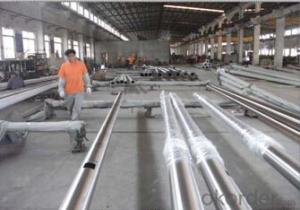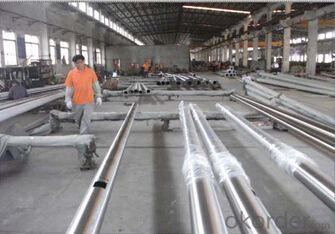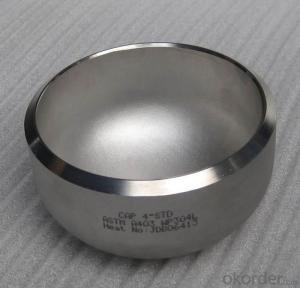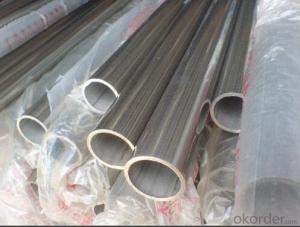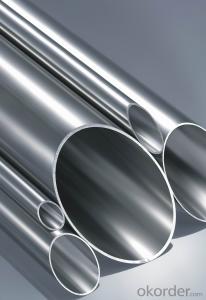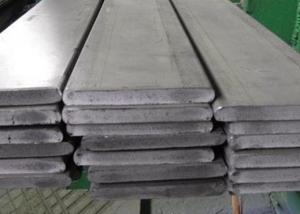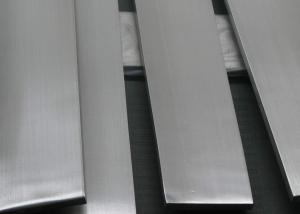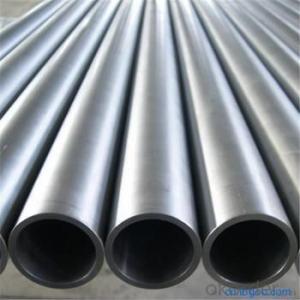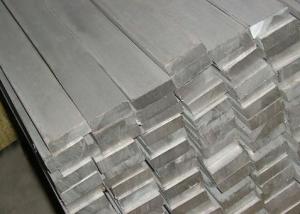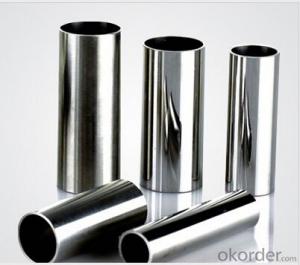FEED WATER STAINLESS PIPE 304
- Loading Port:
- China Main Port
- Payment Terms:
- TT OR LC
- Min Order Qty:
- -
- Supply Capability:
- -
OKorder Service Pledge
Quality Product, Order Online Tracking, Timely Delivery
OKorder Financial Service
Credit Rating, Credit Services, Credit Purchasing
You Might Also Like
Specifications
1. Guaranteed material from established steel factories2. Accordance with International standard
3. Attractive 304 316price
PRODUCT NAME: 304 FEED WATER PIPE
| Name | 304 FEED WATER PIPE |
| Standard | ASTM, GB, JIS, DIN, EN, AISI |
| Material Grade | TP304 TP304L TP316 TP316L TP347 TP347H TP321 TP321H TP310 TP310S |
| TP410 TP410S TP403 | |
| S31803/S32205 S32750 S32760 | |
| Outer Diameter | Welded Pipe: single slit(Φ8mm-Φ630mm); girth(Φ630mm-Φ3000mm), |
| Thickness | Welded Pipe: single slit(0.5mm-25mm); girth(3mm-30mm) |
| Length | Commonly 5.8 Meters or 6.0 Meters, or as customers' request |
| Tolerance | According to the Standard, +/-10% Commonly. |
| Surface | 180#, 320#, 400# Satin / Hairline, Bright Anneal, Pickle,400#, 500#, 600# or 800# Mirror finish |
| Application | Petrochemical industry, chemical fertilizer industry, oil refining industry, oil and gas industry, light industry and food industry, pulp and paper industry, energy and environmental industries. |
| Test | Flaring test, Flattening test, Bending Test, Hydraulic Test, Eddy Current test |
- Q: How do stainless steel pipes compare to galvanized steel pipes?
- Stainless steel pipes and galvanized steel pipes are both commonly used in various industries and applications, but they have distinct differences in terms of their composition, properties, and performance. One of the primary differences between stainless steel and galvanized steel pipes is their composition. Stainless steel pipes are made from an alloy of iron with a minimum of 10.5% chromium content, which provides excellent corrosion resistance and durability. On the other hand, galvanized steel pipes are steel pipes that have been coated with a layer of zinc to protect them from corrosion. In terms of corrosion resistance, stainless steel pipes outperform galvanized steel pipes. The chromium content in stainless steel forms a passive layer of chromium oxide on the surface, which acts as a barrier against corrosion and rust. This makes stainless steel pipes highly resistant to pitting, crevice corrosion, and general corrosion caused by various substances and environmental factors. Galvanized steel pipes, although coated with zinc, are more susceptible to corrosion over time, especially when exposed to harsh conditions or corrosive substances. Another key difference lies in their durability and lifespan. Stainless steel pipes are known for their exceptional strength, toughness, and longevity. They can withstand high pressures, extreme temperatures, and mechanical stresses, making them suitable for demanding applications. Galvanized steel pipes, while durable, have a relatively shorter lifespan compared to stainless steel due to the eventual degradation of the zinc coating, which exposes the underlying steel to corrosion. In terms of maintenance, stainless steel pipes require minimal upkeep due to their inherent corrosion resistance. They are easy to clean and do not require regular painting or coating. On the other hand, galvanized steel pipes may require periodic inspection, maintenance, and re-coating to ensure prolonged protection against corrosion. Cost-wise, galvanized steel pipes are generally more economical upfront compared to stainless steel pipes. However, when considering the long-term benefits of stainless steel's corrosion resistance and durability, the overall cost-effectiveness of stainless steel pipes often surpasses that of galvanized steel pipes. In conclusion, stainless steel pipes offer superior corrosion resistance, durability, and longevity compared to galvanized steel pipes. While galvanized steel pipes may be more cost-effective upfront, stainless steel pipes provide long-term benefits and performance advantages, making them a preferred choice in many applications where corrosion resistance and durability are critical considerations.
- Q: How do you prevent pressure loss in stainless steel pipes?
- To prevent pressure loss in stainless steel pipes, one can take several important steps: 1. Ensure proper pipe sizing: It is crucial to choose the appropriate diameter for the stainless steel pipe based on the system's flow rate and pressure requirements. Using pipes that are too small can result in increased pressure loss due to higher fluid velocities. 2. Reduce pipe length and bends: It is advisable to keep the stainless steel pipe as short as possible and minimize the number of bends or elbows. Lengthy pipes and multiple bends introduce friction and turbulence, which lead to pressure loss. 3. Opt for a smooth interior surface: Select stainless steel pipes with a smooth interior surface finish. This helps minimize pressure loss by reducing frictional resistance and turbulence. 4. Minimize unnecessary fittings and valves: Each fitting or valve in a stainless steel pipe system adds additional pressure loss. To maintain pressure, it is best to minimize the use of unnecessary fittings and valves, selecting those with low resistance instead. 5. Ensure proper installation: Correctly installing stainless steel pipes with proper alignment and support is crucial. Misaligned or poorly supported pipes can cause excessive stress and potential deformation, resulting in pressure loss. 6. Regular maintenance and cleaning: Periodically inspect and clean the stainless steel pipes to remove any accumulated scale, debris, or deposits. These obstructions can restrict flow and lead to pressure loss. 7. Consider flow control devices: Depending on the application, incorporating flow control devices such as flow restrictors, pressure regulators, or flow meters can help maintain optimal pressure levels in the stainless steel pipe system. By implementing these measures, one can minimize pressure loss in stainless steel pipes, ensuring efficient and effective fluid transportation within the system.
- Q: What is the difference between Schedule 30 and Schedule 40 stainless steel pipes?
- Stainless steel pipes are classified into Schedule 30 and Schedule 40 based on their wall thickness and pressure ratings. The primary distinction lies in the wall thickness. Schedule 30 stainless steel pipes possess a slimmer wall in comparison to Schedule 40 pipes. Generally, the wall thickness of Schedule 30 pipes is less than that of Schedule 40 pipes. Consequently, Schedule 30 pipes exhibit a larger internal diameter than Schedule 40 pipes of the same nominal size. The pressure rating and strength of the pipes are directly influenced by the thickness of the pipe walls. Schedule 40 stainless steel pipes are engineered to withstand higher pressure and exhibit greater structural integrity as a result of their thicker walls. They find common usage in industrial settings or for plumbing systems in commercial buildings that involve the transportation of high-pressure fluids or gases. Conversely, Schedule 30 stainless steel pipes are typically employed in applications with lower pressure requirements. They are suitable for situations where more moderate pressure demands exist or where the transported fluid does not necessitate a higher pressure rating. To summarize, the primary disparity between Schedule 30 and Schedule 40 stainless steel pipes resides in their wall thickness. Schedule 40 pipes possess thicker walls and higher pressure ratings compared to Schedule 30 pipes. The choice between the two depends on the specific requirements of the application, including the pressure and nature of the transported fluid.
- Q: What is the maximum allowable working pressure for stainless steel pipes?
- The maximum allowable working pressure for stainless steel pipes depends on various factors such as the grade of stainless steel, pipe size, wall thickness, and temperature. It is typically determined using industry standards and codes, such as ASME B31.3 for process piping. Therefore, there is no one-size-fits-all answer to this question and it is important to consult the relevant standards and engineering guidelines for accurate and specific information.
- Q: The difference between stainless steel pipe and stainless steel composite pipe
- Stainless steel pipe is a kind of hollow long strip round steel, mainly used in petroleum, chemical, medical, food, light industry, machinery, instrument and other industrial pipeline and mechanical structure parts. In addition, the bending and torsional strength of the same weight is lighter, so it is also widely used in the manufacture of mechanical parts and engineering structures. It is also used to produce all kinds of conventional weapons, guns, shells and so on.
- Q: What is the difference between 304 and 304L stainless steel pipes?
- The carbon content is the primary distinguishing factor between 304 and 304L stainless steel pipes. 304 pipes contain a maximum of 0.08% carbon, while 304L pipes have a maximum of 0.03% carbon. The reduced carbon content in 304L pipes helps prevent carbide precipitation during welding, which can cause intergranular corrosion. 304L stainless steel pipes are more resistant to sensitization, a process where chromium carbides form at grain boundaries, leading to decreased corrosion resistance. This makes 304L pipes ideal for applications in high-temperature and corrosive environments, such as the food processing industry or chemical plants. Both 304 and 304L stainless steel pipes exhibit similar mechanical properties in terms of strength and hardness. However, the lower carbon content in 304L pipes may result in slightly higher tensile and yield strength compared to 304 pipes. Additionally, 304L pipes possess improved welding and forming characteristics, making them more manageable during fabrication. To summarize, the principal distinction between 304 and 304L stainless steel pipes lies in their carbon content. The lower carbon content in 304L pipes reduces the risk of sensitization and carbide precipitation during welding, making them better suited for applications in high-temperature and corrosive environments.
- Q: Can stainless steel pipes be tempered?
- Stainless steel pipes have the capability to undergo tempering, which is a heat treatment technique commonly employed to enhance the mechanical properties of steel. To achieve this, the stainless steel pipes are heated to a specific temperature and then carefully cooled. This procedure aids in reducing the steel's hardness and brittleness, thus increasing its ductility and resistance to cracking or breaking. Moreover, tempering can also improve the corrosion resistance of stainless steel pipes. However, it is worth noting that the tempering process and temperature requirements can vary depending on the specific grade of stainless steel utilized. Therefore, it is vital to consult the manufacturer's guidelines or seek advice from a metallurgical expert in order to determine the appropriate tempering procedure for stainless steel pipes.
- Q: Can stainless steel pipes be used for pharmaceutical storage?
- Yes, stainless steel pipes can be used for pharmaceutical storage. Stainless steel is a preferred material in pharmaceutical industry due to its corrosion resistance, hygienic properties, and ease of cleaning. It ensures the integrity and purity of pharmaceutical products, making it suitable for storage and transportation of pharmaceutical materials.
- Q: Why is stainless steel magnetic?
- Many customers often think that the magnet adsorption of stainless steel, to verify its merits and authenticity, and do not smoke without magnetism, that is good, genuine; smokers are magnetic, is considered a fake fake. In fact, this is a very one-sided, not practical, and the wrong way to identify, I hope the following content for your help!
- Q: How are stainless steel pipes insulated?
- Stainless steel pipes are typically insulated using a variety of methods to ensure thermal efficiency and prevent heat loss or condensation. One common method is to use insulation materials such as mineral wool or fiberglass, which are wrapped around the pipes and held in place with a metal jacket. This insulation material helps to reduce heat transfer and maintain the desired temperature of the fluid inside the pipe. Another method of insulating stainless steel pipes is by using foam insulation. Foam insulation is applied directly to the surface of the pipe and then covered with a protective layer, such as a PVC jacket. This type of insulation provides a seamless and moisture-resistant barrier, preventing any heat loss or condensation from occurring. In certain cases, stainless steel pipes may also be insulated using a process called "cladding". Cladding involves applying a layer of insulating material, such as aluminum or stainless steel, to the outside surface of the pipe. This method provides additional protection against external elements and helps to maintain the desired temperature within the pipe. Overall, the insulation of stainless steel pipes is crucial in various industries where maintaining temperature control is essential, such as in oil and gas, chemical processing, or HVAC systems. The specific method of insulation chosen depends on the application, desired temperature range, and environmental factors surrounding the pipe.
Send your message to us
FEED WATER STAINLESS PIPE 304
- Loading Port:
- China Main Port
- Payment Terms:
- TT OR LC
- Min Order Qty:
- -
- Supply Capability:
- -
OKorder Service Pledge
Quality Product, Order Online Tracking, Timely Delivery
OKorder Financial Service
Credit Rating, Credit Services, Credit Purchasing
Similar products
Hot products
Hot Searches
Related keywords
